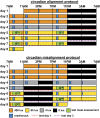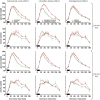Endogenous circadian system and circadian misalignment impact glucose tolerance via separate mechanisms in humans
- PMID: 25870289
- PMCID: PMC4418873
- DOI: 10.1073/pnas.1418955112
Endogenous circadian system and circadian misalignment impact glucose tolerance via separate mechanisms in humans
Abstract
Glucose tolerance is lower in the evening and at night than in the morning. However, the relative contribution of the circadian system vs. the behavioral cycle (including the sleep/wake and fasting/feeding cycles) is unclear. Furthermore, although shift work is a diabetes risk factor, the separate impact on glucose tolerance of the behavioral cycle, circadian phase, and circadian disruption (i.e., misalignment between the central circadian pacemaker and the behavioral cycle) has not been systematically studied. Here we show--by using two 8-d laboratory protocols--in healthy adults that the circadian system and circadian misalignment have distinct influences on glucose tolerance, both separate from the behavioral cycle. First, postprandial glucose was 17% higher (i.e., lower glucose tolerance) in the biological evening (8:00 PM) than morning (8:00 AM; i.e., a circadian phase effect), independent of the behavioral cycle effect. Second, circadian misalignment itself (12-h behavioral cycle inversion) increased postprandial glucose by 6%. Third, these variations in glucose tolerance appeared to be explained, at least in part, by different mechanisms: during the biological evening by decreased pancreatic β-cell function (27% lower early-phase insulin) and during circadian misalignment presumably by decreased insulin sensitivity (elevated postprandial glucose despite 14% higher late-phase insulin) without change in early-phase insulin. We explored possible contributing factors, including changes in polysomnographic sleep and 24-h hormonal profiles. We demonstrate that the circadian system importantly contributes to the reduced glucose tolerance observed in the evening compared with the morning. Separately, circadian misalignment reduces glucose tolerance, providing a mechanism to help explain the increased diabetes risk in shift workers.
Keywords: circadian disruption; diabetes; glucose metabolism; night work; shift work.
Conflict of interest statement
Conflict of interest statement: O.M.B. has received two investigator-initiated grants from Sepracor (now Sunovion; ESRC-0004 and ESRC-0977;
Figures






References
-
- Carroll KF, Nestel PJ. Diurnal variation in glucose tolerance and in insulin secretion in man. Diabetes. 1973;22(5):333–348. - PubMed
-
- Service FJ, et al. Effects of size, time of day and sequence of meal ingestion on carbohydrate tolerance in normal subjects. Diabetologia. 1983;25(4):316–321. - PubMed
-
- Shapiro ET, et al. Oscillations in insulin secretion during constant glucose infusion in normal man: relationship to changes in plasma glucose. J Clin Endocrinol Metab. 1988;67(2):307–314. - PubMed
Publication types
MeSH terms
Substances
Grants and funding
LinkOut - more resources
Full Text Sources
Other Literature Sources
Medical

